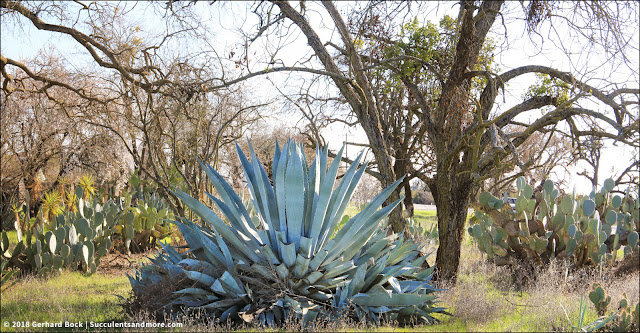A spiky surprise in the country
I live in Davis, about 15 miles west of Sacramento, the capital of California. Our town of 65,000 is surrounded by a flood plain to the east and agricultural land everywhere else. As soon you leave the city limits, you're in the country.
This fact became very clear when I visited Three Palms Nursery. Located about 7 miles west of downtown Davis, the nursery is located all by its lonesome in the middle of fields. A peaceful and bucolic spot indeed.
But the topic of this post isn't Three Palms Nursery although I'm planning a return trip later in the month. Rather, I want to you show you what I found on the way home.
Just before you enter Davis proper, there's an empty lot at the intersection of two county roads. Except it's not exactly empty. True, there's no house on it, but somebody has been using it as their desert garden. It's conceivable that some of the Agave americana and prickly pears appeared on their own—they do naturalize around here. But the other assorted cacti were definitely added by a human.
Let's take a look!
I'm not a fan of pineappling agaves but hey, it's not my call. Look at the sheer number of pups, though. And there are many more on the other side.
This fact became very clear when I visited Three Palms Nursery. Located about 7 miles west of downtown Davis, the nursery is located all by its lonesome in the middle of fields. A peaceful and bucolic spot indeed.
But the topic of this post isn't Three Palms Nursery although I'm planning a return trip later in the month. Rather, I want to you show you what I found on the way home.
Just before you enter Davis proper, there's an empty lot at the intersection of two county roads. Except it's not exactly empty. True, there's no house on it, but somebody has been using it as their desert garden. It's conceivable that some of the Agave americana and prickly pears appeared on their own—they do naturalize around here. But the other assorted cacti were definitely added by a human.
Let's take a look!
I must admit, this Agave americana does have presence.
Prickly pears, typically Opuntia ficus-indica, are a common sight in rural areas. Just as common is scale infestation (the cottony deposits on the pads). Cochineal scale and prickly pears go hand in hand. It's just a matter of time before your opuntia ends up with scale. That's one of the reasons I've given up on opuntias. (The main reason are the d***n glochids that get me every time.)
There's no rhyme or reason to the plantings (if indeed they are deliberate plantings). It's just a jumble of spiky goodness, and there's a disarming charm about that.
More plants are being added, as you can see in the next photo:
The two in the photo below are very cozy. But I have news for them. Their relationship won't last. They'll be in each other's face very soon, and one of them will have to leave.
It's been a dry winter, at least compared to last year. Opuntia paddles shrivel when water is scare and plump up after a period of rain:
One last look at the tangle of cactus:
I wish I knew the story behind this "garden." I will ask around to see if anybody knows.











It's a "jumble of spiky goodness" indeed. The photo with the new plants being added is kind of hilarious. It looks like someone is taking their extras and just sticking them in the ground. I love it!
ReplyDeleteYou've never noticed cactus corners before? Its been there for at least 40 years. There is a story behind it, but I can't remember it offhand. I do know the original guy who created it is gone, and the severe freeze we had sometime in the 90's killed most of the original plants. I think the boy scouts replanted it, and someone else is caring for it and adding to it now. What's so amazing is there is no supplemental irrigation. Go out in early May when the Opuntia imbricata is blooming, it's spectacular due to it's size. Sue
ReplyDeleteI love guerrilla gardens like this and it's wonderful that, as Sue describes, someone has taken on the responsibility of keeping it going. Re Opuntias, I'd coveted Opuntia 'Santa Rita' for a long time until a friend gave me a couple of pads, quickly ending my plant crush.
ReplyDeleteI mentioned you yesterday when I visited 3 Palms Nursery, Phil remembered you visiting. The ride out there was great, I came back via Road 95A, to Pitt School Rd. Back to the congestion of I80...
ReplyDeleteCactus Corners -- I want to learn more about it. In our California home, I had a section I called the rehab center for plants that needed some time to recuperate from deer damage or for any "extras". I wonder how this was started...
ReplyDelete